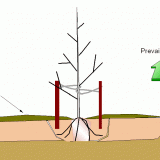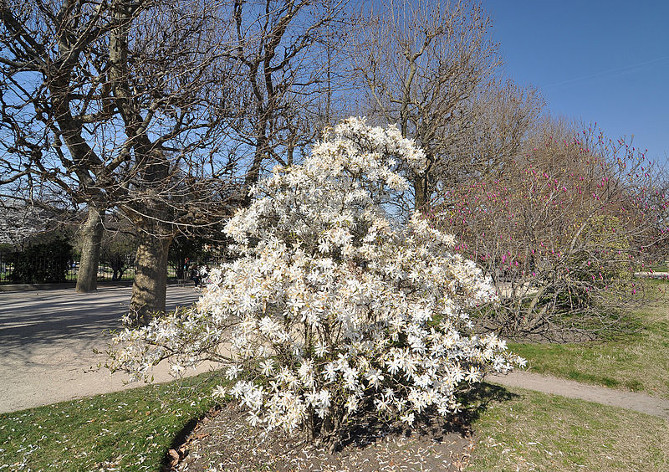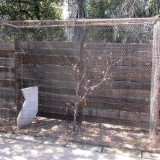
Polyphagus Shot Hole Borer, from UC Riverside’s Eskalen Lab
Seems the greater LA area is ground zero for the introduction of yet another exotic beetle which is killing our our beautiful native oaks and sycamores, our landscape trees, even our beloved avocado trees.
The good news is that the fungal disease propagated by the beetle can be treated if detected early. You’ll need the services of a professional arborist, but the cost of treatment will likely be less than the cost of tearing out a mature tree.
Look at this link to UC Riverside’s Eskalen Lab. Here they have several PDFs on identifying and treating the disease. They also have a map showing the spread of the disease. Of course, these are only reported infections–it could be much more widely spread.
(Note: a separate invasion was recently detected in the commercial avocado groves of San Diego county, so folks further south should be on alert too.)

Since this pest threatens the avocado crop, you can bet there’s lots of research and money being thrown at it. But as individuals we can help by reporting diseased trees, so researchers can better track the spread of the beetle, and by treating our own trees to prevent further loss. We don’t want to lose our native trees to this. We don’t want to see this disease spread to the rest of the country.
Polyphagus means “eats everything” and accordingly this beetle doesn’t seem all that picky about which trees it infests. The following list (via UC Riverside’s Eskalen Labs) of know hosts keeps growing:
Known Suitable Reproductive Host Trees:
3. Evergreen Maple (Acer paxii)4. Trident maple (Acer buergerianum)5 Japanese maple (Acer palmatum)6. Castor bean (Ricinus communis)8. Mexizan sycamore (Platanus mexicana)10. Avocado (Persea americana)11. Mimosa (Albizia julibrissin)12. English Oak (Quercus robur)15.Cottonwood (Populus fremontii)*16. Black cottonwood (Populus trichocarpa)*17. White Alder (Alnus rhambifolia)*18.Titoki (Alectryon excelsus)20. Cork Oak (Quecus suber)22. Coral tree (Erythrina corallodendon)24. Palo verde (Parkinsonia aculeata)25. Moreton Bay Chestnut (Castanospermum australe)26. Brea (Cercidium sonorae)27. Mesquite (Prosopis articulata)*28. Weeping willow (Salix babylonica)29. Chinese holly (Ilex cornuta)30. Camelia (Camellia semiserrata)31. Acacia (Acacia spp.)32. Liquidambar (Liquidambar styraciflua)33. Red Flowering Gum (Eucalyptus ficifolia)34. Japanese wisteria (Wisteria floribunda)35. Goodding’s black willow (Salix gooddingii)*36. Tree of heaven (Alianthus altissima)37. Kurrajong (Brachychiton populneus)*Native species to California
The Shot Hole Borer burrows into trees. Its tunneling alone would not harm a healthy tree much, but it carries with it three different types of fungus, and it farms this fungus within the tree–it eats the fungus it cultivates, which I have to admit, is kind of neat. But the resulting fungal infection kills the host tree. When this happens, the beetles simply move to the next tree.
One of the classic symptoms of the fungal infection is dark spots appearing on the trunk of the tree, spots which look almost like oil stains. Another sign is white, sugary patches on the trunk. (Again, see the PDFs I linked to above for more pictures) If you look closely at these areas, you may see the tiny entry holes of the beetle, holes about the size of the tip of a ballpoint pen. You will need a professional arborist to confirm the infestation, report it, and determine treatment.
The Shot Hole Borer is more likely to infect drought stressed trees, and most of our trees in Southern California are drought stressed right now. It’s a perfect storm.
So now, more than ever, it is time to take care of your trees. Our trees have been gamely enduring the drought for the last few years, but this year, tree experts tell me, the signs of deep distress are appearing. We’re at risk losing many trees due to drought alone this summer. The Shot Hole Borer is merely upping the stakes.
Keep in mind that a mature tree needs to be watered such that the water penetrates to a depth of two or three feet. That’s no quick sprinkle with a hose! Visit the Inland Urban Forest Council to download a PDF about how to properly water your trees. Also, we might suggest that this is a great time to install a laundry to landscape graywater system.
Many thanks to our excellent arborist, Nick Araya of Tree Care LA, who came out yesterday to look at our drought-stressed avocado tree (no beetles yet, thankfully!) and gave me the 411 on the Polyphagus Shot Hole Borer.




We cut down an ornamental plum tree yesterday that had the white fungus and bore holes. I’ll grab some samples from the green bin for reporting. Thanks for the update. So unfortunate!
The previous post specifies an ornamental plum, we have lost two apricots and the symptoms are quite similar (from my recollection – when I am next in the garden on Wednesday, you can bet I’m going to be looking into this), yet, in the list I don’t see rose family fruits listed at all. It seems like that would be a priority – right up there with avocados. That makes me wonder if I’m mistaken…. I do know most of our trees are drought stressed – some a bit more than others. Maybe it’s just that….
The list is fast-evolving, so plums could end up on it.
That possibility aside, Arborist Nick and I were talking about fruit trees when he visited–he commented that it has been a miserable year for stone fruit everywhere he goes–lack of fruit, dropped leaves etc. Because the failure is so universal he thinks it must have something to do with our odd weather–a blistering March followed by a cold May and June. Our nectaplum looks like it is on death’s doorstep, but he didn’t see any sign of infection.
Thanks for posting this! We need to know about this.
At some point you might also consider telling your so. Cal readers about Huanglongbing (Citrus Greening) and the Asian Citrus Psyllid… and to avoid transporting citrus anywhere… (http://ucanr.edu/News/Asian_citrus_psyllid_and_huanglongbing_disease/)
sigh, more depressing tree news…
They have definitely been on the forfront of that. One of several posts:
https://rootsimple.wpengine.com/2009/09/the-end-of-california-citrus/
I need help our fruit and avocado trees are having bark issues – who is the best expert to call and get a diagnosis and help
You’ll find a link to Tree Care LA at the end of the post.
So far, there isn’t any fungus seen on our beloved oak tree. I’ll keep a very close eye on it, though. This tree carries just too much memory to be eaten up by fungus. Thanks for the information!
Pingback: Dancing with life and death | Otherwise